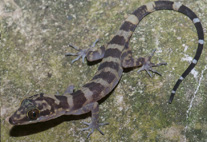Abstract
Two new species of the feather mite family Pteronyssidae (Acariformes: Analgoidea) from passerines of the families Leiothrichidae and Pycnonotidae in India (Meghalaya, East Jaintia Hills District) are described: Timalinyssus actinodurae Constantinescu sp. nov. from Actinodura cyanouroptera (Hodgson) (Leiothrichidae) and Pteroherpus meghalayensis Constantinescu sp. nov. from Hemixos flavala Blyth (Pycnonotidae). Timalinyssus actinodurae differs from all of the other species of the genus due to a particular shape of the opisthosomal lobes in both sexes and having a strong sclerotised band in postero-median area of the hysteronotal shield in male. The male of Pteroherpus meghalayensis differs due to a very long genital apparatus and unusual length of the tips of epiandrum that extend the level of the genital apparatus.

